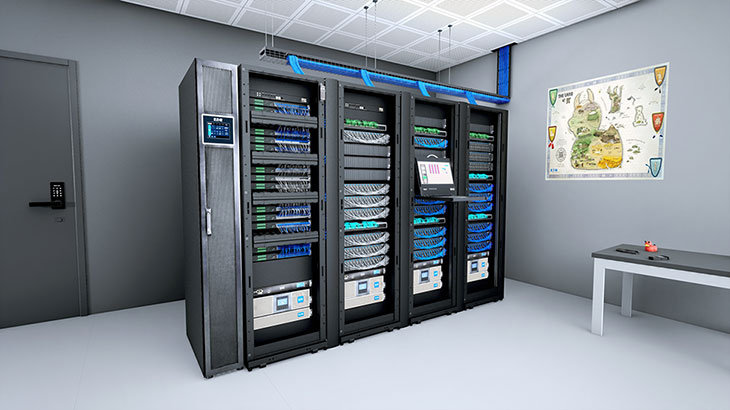Download document () of 20
Download
You have exceeded the download limit
Server room refresh
Let’s face it, you’ve probably seen (or overseen) a server room that keeps you up at night. From messy, tangled cabling and untraceable connections to improperly installed equipment and poor ventilation, it can truly be the thing of nightmares.
Not only equipment problems haunt the server room—basics as obvious as trash, unlocked doors and windows letting in sunlight (not to mention lack of security!) create an inefficient and unsafe environment for sensitive equipment. This can result in downtime, equipment damage and loss of data paramount to running your operations.
Click each of the hot spots below to learn more about server room refresh best practices and how Eaton can help make yours a dream come true.
 While fire safety is of great importance, it’s also important to keep the fire extinguisher and ceiling sprinkler system away from sensitive electronics.
While fire safety is of great importance, it’s also important to keep the fire extinguisher and ceiling sprinkler system away from sensitive electronics.
 Not only will you sleep better at night knowing where each connection leads, a clean, clearly labeled rack reduces clutter and accidental disconnections.
Not only will you sleep better at night knowing where each connection leads, a clean, clearly labeled rack reduces clutter and accidental disconnections.
 Start with the heaviest equipment at the bottom—that means your UPS! Work your way up and place less power-intensive equipment (with less heat draw) toward the top.
Start with the heaviest equipment at the bottom—that means your UPS! Work your way up and place less power-intensive equipment (with less heat draw) toward the top.
 Redundant power is reliable power—use an automatic transfer switch (ATS) to power devices from two sources should one source fail—meaning no interruption to connected equipment.
Redundant power is reliable power—use an automatic transfer switch (ATS) to power devices from two sources should one source fail—meaning no interruption to connected equipment.
 Make a plan when populating racks, including placing heavier equipment at the bottom and leaving space for future growth. (Not pictured: secure your equipment with locking rack doors!)
Make a plan when populating racks, including placing heavier equipment at the bottom and leaving space for future growth. (Not pictured: secure your equipment with locking rack doors!)
 Your equipment deserves an on-site security guard, but a closed, locking door will have to suffice. Key-free biometric locks provide easy, secure access and peace of mind.
Your equipment deserves an on-site security guard, but a closed, locking door will have to suffice. Key-free biometric locks provide easy, secure access and peace of mind.
 It takes much more than a floor fan to keep power hungry devices cool! In-row cooling provides primary, close-coupled cooling with remote management capabilities, eliminating the need for on-site monitoring.
It takes much more than a floor fan to keep power hungry devices cool! In-row cooling provides primary, close-coupled cooling with remote management capabilities, eliminating the need for on-site monitoring.

This page is best viewed on a larger device.
Environment
The first thing to do is assess the physical space—where are entryways, windows, ducts and lighting? Where is your power source and is it accessible for equipment connection? Answering these questions from the start will help you build out your current infrastructure and plan for future growth.
Power
Server rooms contain mission-critical equipment and require UPS systems to ensure continuous power. Not only will you get peace of mind when power outages occur, UPSs also provide protection against power fluctuations and surges.
Storage
Proper server rack installation and management is crucial for efficient operation, safety and organization of racks and the equipment they contain.
Cables & Cable Management
The server room is your control center where every connection counts—make sure you can find each cable and where it leads! Efficient routing and organization in paramount to keeping control of your power and data. Starting with a connection map helps identify every connection, especially problem areas.
Security
Keep security in mind from the very start! You may be concerned with handling essential data, but don’t forget the physical security required to keep sensitive data in the right hands. In addition to cameras in front of and within your server room, it’s good practice to limit access to only necessary staff.
Cooling
Maintaining safe temperatures is critical to the operation of your server room. Depending on your room size and the equipment installed, building HVAC may not cut it (and shouldn’t be run 7x24 anyway!) The ideal temperature should be between 68 and 72 degrees, but there are other environmental aspects to keep in mind as well.